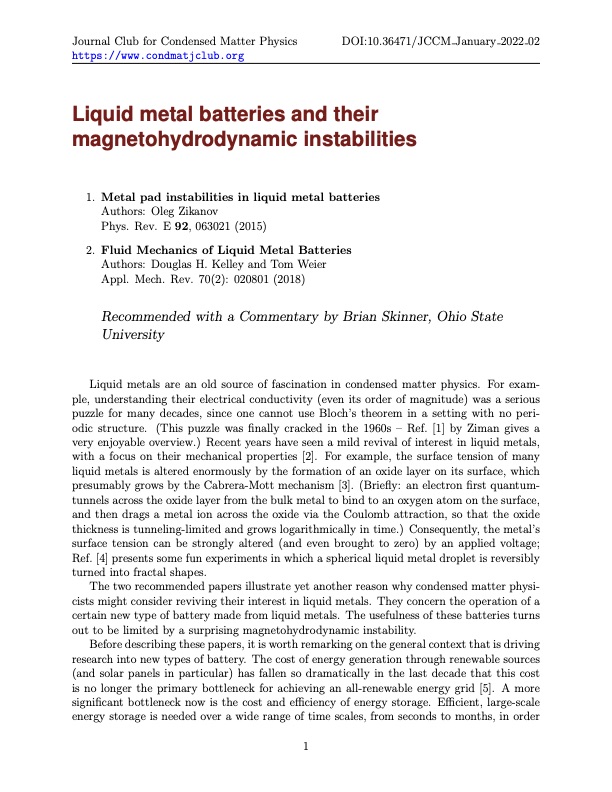
PDF Publication Title:
Text from PDF Page: 001
Journal Club for Condensed Matter Physics DOI:10.36471/JCCM January 2022 02 https://www.condmatjclub.org Liquid metal batteries and their magnetohydrodynamic instabilities 1. Metal pad instabilities in liquid metal batteries Authors: Oleg Zikanov Phys. Rev. E 92, 063021 (2015) 2. Fluid Mechanics of Liquid Metal Batteries Authors: Douglas H. Kelley and Tom Weier Appl. Mech. Rev. 70(2): 020801 (2018) Recommended with a Commentary by Brian Skinner, Ohio State University Liquid metals are an old source of fascination in condensed matter physics. For exam- ple, understanding their electrical conductivity (even its order of magnitude) was a serious puzzle for many decades, since one cannot use Bloch’s theorem in a setting with no peri- odic structure. (This puzzle was finally cracked in the 1960s – Ref. [1] by Ziman gives a very enjoyable overview.) Recent years have seen a mild revival of interest in liquid metals, with a focus on their mechanical properties [2]. For example, the surface tension of many liquid metals is altered enormously by the formation of an oxide layer on its surface, which presumably grows by the Cabrera-Mott mechanism [3]. (Briefly: an electron first quantum- tunnels across the oxide layer from the bulk metal to bind to an oxygen atom on the surface, and then drags a metal ion across the oxide via the Coulomb attraction, so that the oxide thickness is tunneling-limited and grows logarithmically in time.) Consequently, the metal’s surface tension can be strongly altered (and even brought to zero) by an applied voltage; Ref. [4] presents some fun experiments in which a spherical liquid metal droplet is reversibly turned into fractal shapes. The two recommended papers illustrate yet another reason why condensed matter physi- cists might consider reviving their interest in liquid metals. They concern the operation of a certain new type of battery made from liquid metals. The usefulness of these batteries turns out to be limited by a surprising magnetohydrodynamic instability. Before describing these papers, it is worth remarking on the general context that is driving research into new types of battery. The cost of energy generation through renewable sources (and solar panels in particular) has fallen so dramatically in the last decade that this cost is no longer the primary bottleneck for achieving an all-renewable energy grid [5]. A more significant bottleneck now is the cost and efficiency of energy storage. Efficient, large-scale energy storage is needed over a wide range of time scales, from seconds to months, in order 1PDF Image | Liquid metal batteries and their magnetohydrodynamic instabilities

PDF Search Title:
Liquid metal batteries and their magnetohydrodynamic instabilitiesOriginal File Name Searched:
JCCM_January_2022_02.pdfDIY PDF Search: Google It | Yahoo | Bing
Sulfur Deposition on Carbon Nanofibers using Supercritical CO2 Sulfur Deposition on Carbon Nanofibers using Supercritical CO2. Gamma sulfur also known as mother of pearl sulfur and nacreous sulfur... More Info
CO2 Organic Rankine Cycle Experimenter Platform The supercritical CO2 phase change system is both a heat pump and organic rankine cycle which can be used for those purposes and as a supercritical extractor for advanced subcritical and supercritical extraction technology. Uses include producing nanoparticles, precious metal CO2 extraction, lithium battery recycling, and other applications... More Info
| CONTACT TEL: 608-238-6001 Email: greg@infinityturbine.com | RSS | AMP |